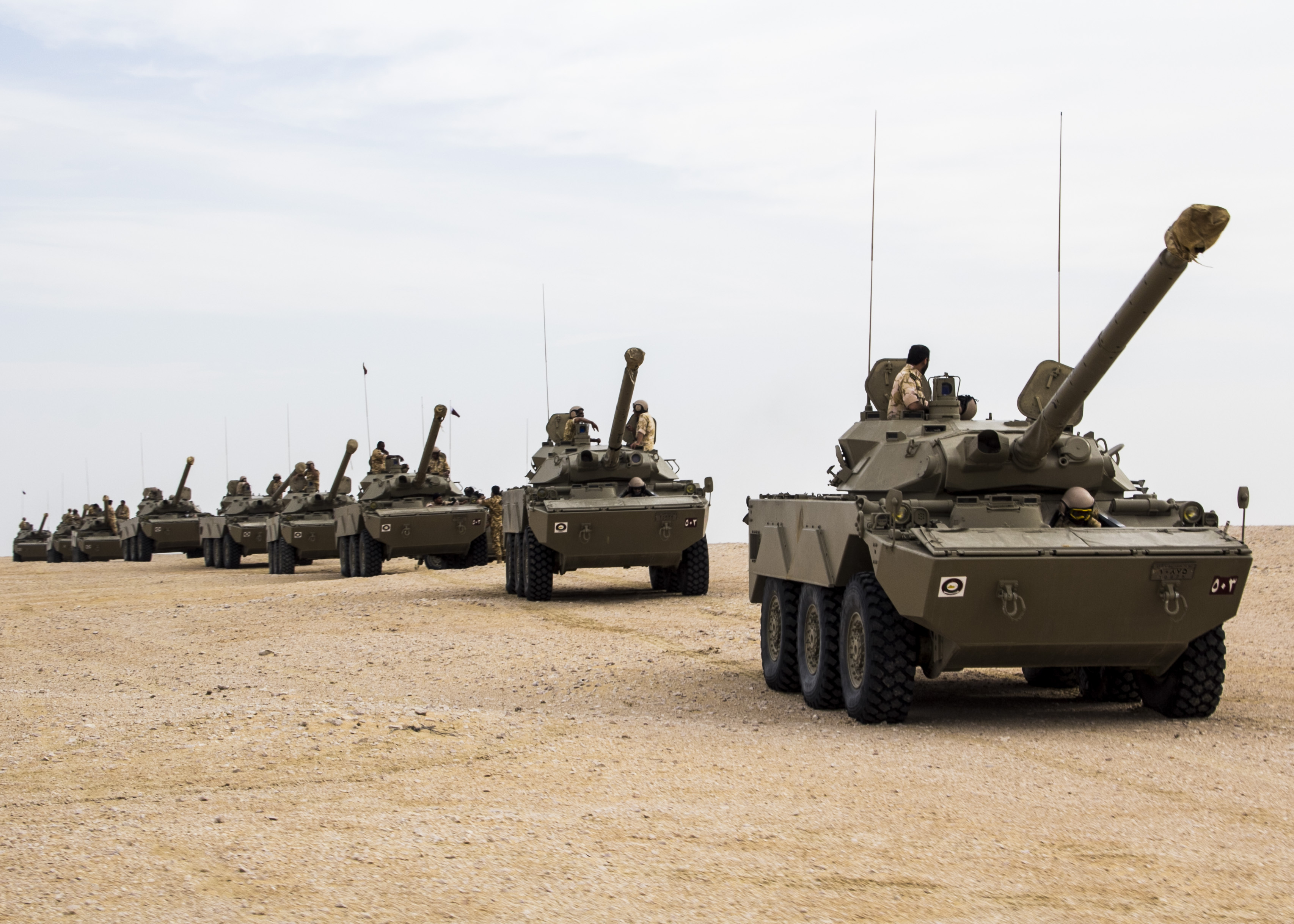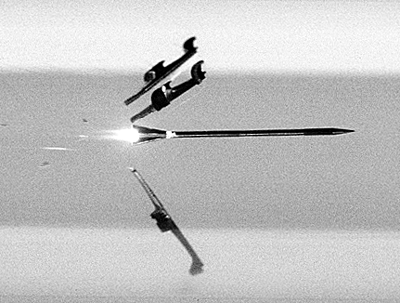|
AMX 10 RC
The AMX-10 RC is a French armoured fighting vehicle manufactured by GIAT for armoured reconnaissance purposes. Equipping French cavalry units since 1981, over 240 are still in service with the French Army as of 2021. In addition, 108 units were sold to Morocco and 12 to Qatar. "RC" stands for "''Roues-Canon''" (meaning "Wheeled gun") and the vehicle can also be described as a wheeled tank destroyer or light tank, being referred to as a "char" (which is the French word for tank) in French service. The AMX-10 RC should not be confused with the AMX-10P; they share automotive components but otherwise have completely different battlefield roles. The AMX-10RC is usually used for reconnaissance missions in dangerous environments or for fire support. It will gradually be replaced in French service by the EBRC Jaguar from 2021 onwards. Design and development Initial work on the AMX-10RC began in 1970; prototypes testing began in 1976, and the first production vehicle was delivered ... [...More Info...] [...Related Items...] OR: [Wikipedia] [Google] [Baidu] |
Western Sahara War
The Western Sahara War ( ar, حرب الصحراء الغربية, french: Guerre du Sahara occidental, es, Guerra del Sahara Occidental) was an armed struggle between the Sahrawi indigenous Polisario Front and Morocco from 1975 to 1991 (and Mauritania from 1975 to 1979), being the most significant phase of the Western Sahara conflict. The conflict erupted after the withdrawal of Spain from the Spanish Sahara in accordance with the Madrid Accords (signed under the pressure of the Green March), by which it transferred administrative control of the territory to Morocco and Mauritania, but not sovereignty. In late 1975, the Moroccan government organized the Green March of some 350,000 Moroccan citizens, escorted by around 20,000 troops, who entered Western Sahara, trying to establish a Moroccan presence. While at first met with just minor resistance by the Polisario Front, Morocco later engaged a long period of guerrilla warfare with the Sahrawi nationalists. During the late ... [...More Info...] [...Related Items...] OR: [Wikipedia] [Google] [Baidu] |
Light Tank
A light tank is a tank variant initially designed for rapid movements in and out of combat, to outmaneuver heavier tanks. It is smaller in size with thinner armor and a less powerful main gun, tailored for better tactical mobility and ease of transport and logistics. They are primarily employed in the screening, armored reconnaissance, skirmishing, artillery observation, and supplementing landing operations in a fire support role of expeditionary forces where larger, heavier tanks are unavailable or have difficulties operating safely or efficiently. The fast light tank was a major feature of the pre-World War II army buildup, where it was expected they would be used to exploit breakthroughs in enemy lines created by slower, heavier tanks, with the goal of disrupting communications and supply lines. Numerous small tank designs and " tankettes" were developed during this period and known under a variety of names, including the " combat car". Early light tank designs were ... [...More Info...] [...Related Items...] OR: [Wikipedia] [Google] [Baidu] |
AMX 30
The AMX-30 is a main battle tank designed by Ateliers de construction d'Issy-les-Moulineaux (AMX, then GIAT) and first delivered to the French Army in August 1966. The first five tanks were issued to the 501st ''Régiment de Chars de Combat'' (Tank Regiment) in August of that year. The production version of the AMX-30B weighed , and sacrificed protection for increased mobility. The French believed that it would have required too much armour to protect against the latest anti-tank threats, thereby reducing the tank's maneuverability. Protection, instead, was provided by the speed and the compact dimensions of the vehicle, including a height of 2.28 metres. It had a 105 mm gun, firing a then advanced high-explosive anti-tank (HEAT) warhead known as the ''Obus G''. The ''Obus G'' used an outer shell, separated from the main charge by ball bearings, to allow the round to be spin stabilized by the gun without spinning the warhead inside which would disrupt jet formation. Mobilit ... [...More Info...] [...Related Items...] OR: [Wikipedia] [Google] [Baidu] |
Low Light Level Television
Low light level television (LLLTV) is a type of electronic sensing device, usually a CCD camera sensitive to wavelengths above the normal "visible" (0.4 to 0.7 micrometre) wavelengths, and into the short-wave Infrared - usually to about 1.0 to 1.1 micrometres. This allows viewing of objects in extremely low light levels, where they would not be seen by the naked eye. LLLTVs tend to be more affordable than infrared cameras, which typically cover ranges from 3 to 5 μm (MWIR)or 8 to 12 μm (LWIR) See also *Night vision *Thermographic camera Infrared thermography (IRT), thermal video and/or thermal imaging, is a process where a thermal camera captures and creates an image of an object by using infrared radiation emitted from the object in a process, which are examples of infrared ... References {{DEFAULTSORT:Low Light Level Television Infrared imaging Cameras by type ... [...More Info...] [...Related Items...] OR: [Wikipedia] [Google] [Baidu] |
NATO Targets
NATO targets are a series of standard armoured targets defined by NATO The North Atlantic Treaty Organization (NATO, ; french: Organisation du traité de l'Atlantique nord, ), also called the North Atlantic Alliance, is an intergovernmental military alliance between 30 member states – 28 European and two N ... designed to test the armour penetration of weapons. The purpose of the triple heavy target is to represent the difficulty a projectile would face in penetrating the skirt, roadwheel, and hull of a Soviet tank. They are defined as: References {{mil-stub NATO Standardization Agreements Targeting (warfare) ... [...More Info...] [...Related Items...] OR: [Wikipedia] [Google] [Baidu] |
HEAT
In thermodynamics, heat is defined as the form of energy crossing the boundary of a thermodynamic system by virtue of a temperature difference across the boundary. A thermodynamic system does not ''contain'' heat. Nevertheless, the term is also often used to refer to the thermal energy contained in a system as a component of its internal energy and that is reflected in the temperature of the system. For both uses of the term, heat is a form of energy. An example of formal vs. informal usage may be obtained from the right-hand photo, in which the metal bar is "conducting heat" from its hot end to its cold end, but if the metal bar is considered a thermodynamic system, then the energy flowing within the metal bar is called internal energy, not heat. The hot metal bar is also transferring heat to its surroundings, a correct statement for both the strict and loose meanings of ''heat''. Another example of informal usage is the term '' heat content'', used despite the fact that ... [...More Info...] [...Related Items...] OR: [Wikipedia] [Google] [Baidu] |
High Explosive
An explosive (or explosive material) is a reactive substance that contains a great amount of potential energy that can produce an explosion if released suddenly, usually accompanied by the production of light, heat, sound, and pressure. An explosive charge is a measured quantity of explosive material, which may either be composed solely of one ingredient or be a mixture containing at least two substances. The potential energy stored in an explosive material may, for example, be * chemical energy, such as nitroglycerin or grain dust * pressurized gas, such as a gas cylinder, aerosol can, or BLEVE * nuclear energy, such as in the fissile isotopes uranium-235 and plutonium-239 Explosive materials may be categorized by the speed at which they expand. Materials that detonate (the front of the chemical reaction moves faster through the material than the speed of sound) are said to be "high explosives" and materials that deflagrate are said to be "low explosives". Expl ... [...More Info...] [...Related Items...] OR: [Wikipedia] [Google] [Baidu] |
APFSDS
Armour-piercing fin-stabilized discarding sabot (APFSDS), long dart penetrator, or simply dart ammunition, is a type of kinetic energy penetrator ammunition used to attack modern vehicle armour. As an armament for main battle tanks, it succeeds Armour-Piercing Discarding Sabot (APDS) ammunition, which is still used in small or medium caliber weapon systems. Improvements in powerful automotive propulsion and suspension systems following World War II allowed modern main battle tanks to incorporate progressively thicker and heavier armour protection systems, while maintaining considerable maneuverability and speed on the battlefield. As a result, achieving deep armour penetration with gun-fired ammunition required even longer anti-armour projectiles fired at even higher muzzle velocity than could be achieved with stubbier APDS projectiles. History Armour-piercing discarding sabot (APDS) was initially the main design of the kinetic energy (KE) penetrator. The logical progression ... [...More Info...] [...Related Items...] OR: [Wikipedia] [Google] [Baidu] |
AMX-10 RC Of Qatar, Eagle Resolve 2013
The America Movil Submarine Cable System-1 (AMX-1) is a fiber optic submarine communications cable of 17,800 kilometers that extends between the United States, Mexico, Guatemala, Colombia, Dominican Republic, Puerto Rico and Brazil. Information The submarine cable means an investment of 500 million of dollars. It connects five countries (Mexico, Guatemala, Colombia, Dominican Republic, Brazil) and one territory (Puerto Rico) with The United States. The cable has a length of 17,500 kilometers, and ends in Miami, Florida. Landing points * Barranquilla, Colombia * Cancún, Mexico * Cartagena, Colombia * Fortaleza, Brazil * Jacksonville, Florida, United States * Miami, Florida, United States * Puerto Barrios, Guatemala * Puerto Plata, Dominican Republic * Rio de Janeiro, Brazil * Salvador, Brazil * San Juan, Puerto Rico San Juan (, , ; Spanish for "Saint John") is the capital city and most populous municipality in the Commonwealth of Puerto Rico, an unincorporated terr ... [...More Info...] [...Related Items...] OR: [Wikipedia] [Google] [Baidu] |
Diesel Engine
The diesel engine, named after Rudolf Diesel, is an internal combustion engine in which ignition of the fuel is caused by the elevated temperature of the air in the cylinder due to mechanical compression; thus, the diesel engine is a so-called compression-ignition engine (CI engine). This contrasts with engines using spark plug-ignition of the air-fuel mixture, such as a petrol engine ( gasoline engine) or a gas engine (using a gaseous fuel like natural gas or liquefied petroleum gas). Diesel engines work by compressing only air, or air plus residual combustion gases from the exhaust (known as exhaust gas recirculation (EGR)). Air is inducted into the chamber during the intake stroke, and compressed during the compression stroke. This increases the air temperature inside the cylinder to such a high degree that atomised diesel fuel injected into the combustion chamber ignites. With the fuel being injected into the air just before combustion, the dispersion of the fuel i ... [...More Info...] [...Related Items...] OR: [Wikipedia] [Google] [Baidu] |
Differential Steering
Differential steering is the means of steering a land vehicle by applying more drive torque to one side of the vehicle than the other. Differential steering is the primary means of steering tracked vehicles, such as tanks and bulldozers, is also used in certain wheeled vehicles commonly known as skid-steer, and even implemented in some automobiles, where it is called torque vectoring, to augment steering by changing wheel direction relative to the vehicle. Differential steering is distinct from torque steer, which is usually considered a negative side effect of drive-train design choices. History A British agricultural company, Hornsby in Grantham, developed a continuous track, which was patented in 1905. The Hornsby tractors featured a track-steer clutch arrangement. Mechanisms There are several mechanisms that have been developed to vary the torque applied to different sides of a vehicle. These include ''clutch-brake'' steering, ''braked-differential'' steering, '' ... [...More Info...] [...Related Items...] OR: [Wikipedia] [Google] [Baidu] |





